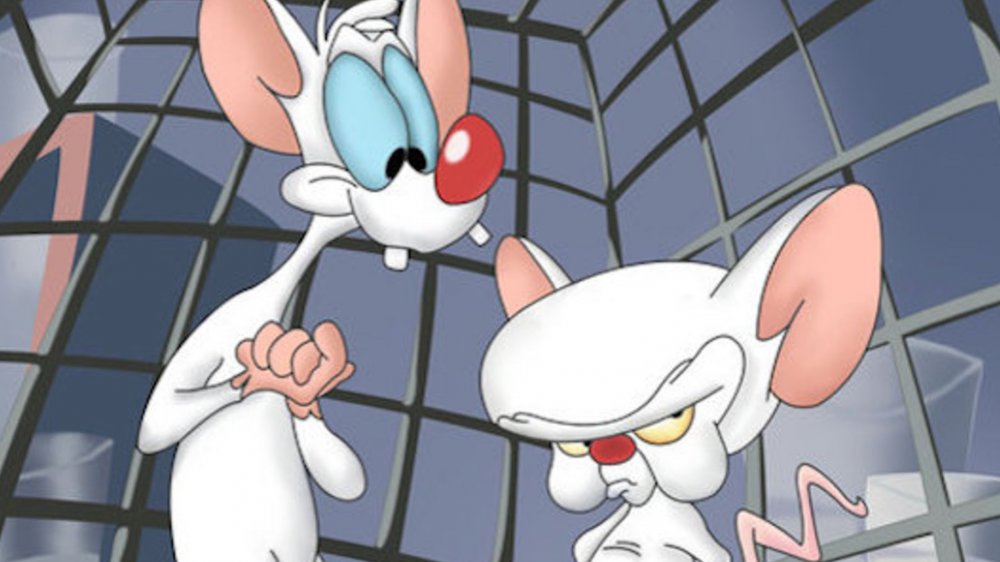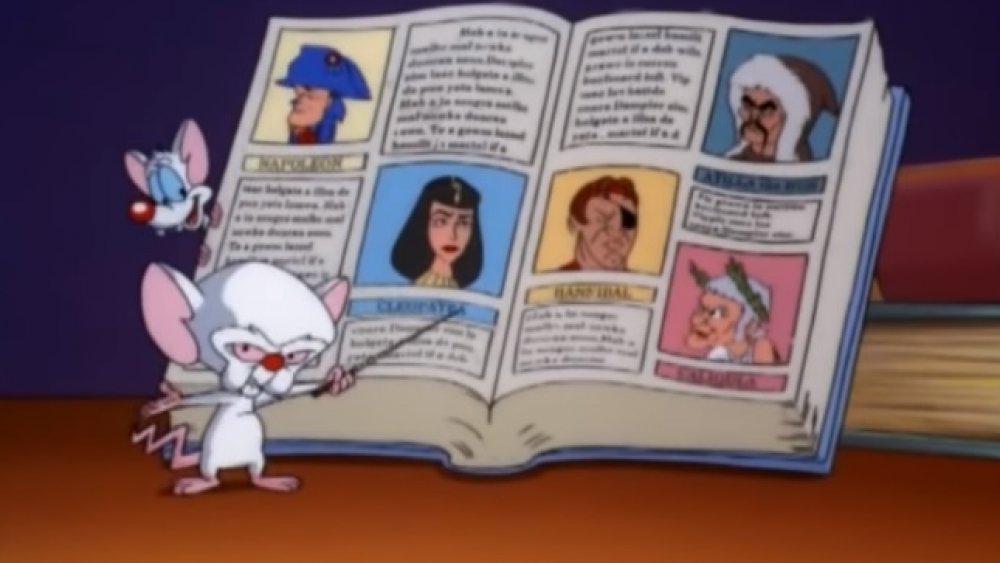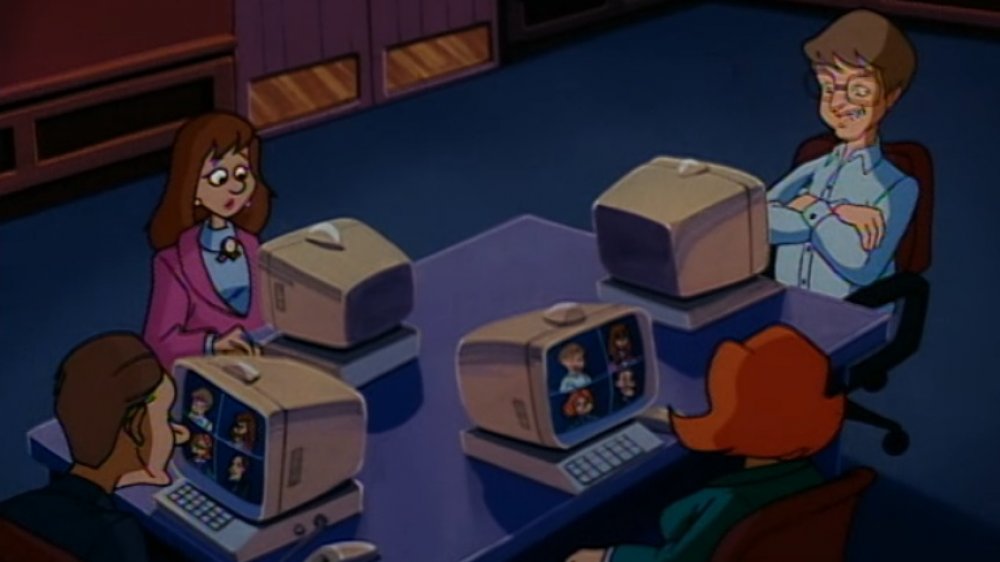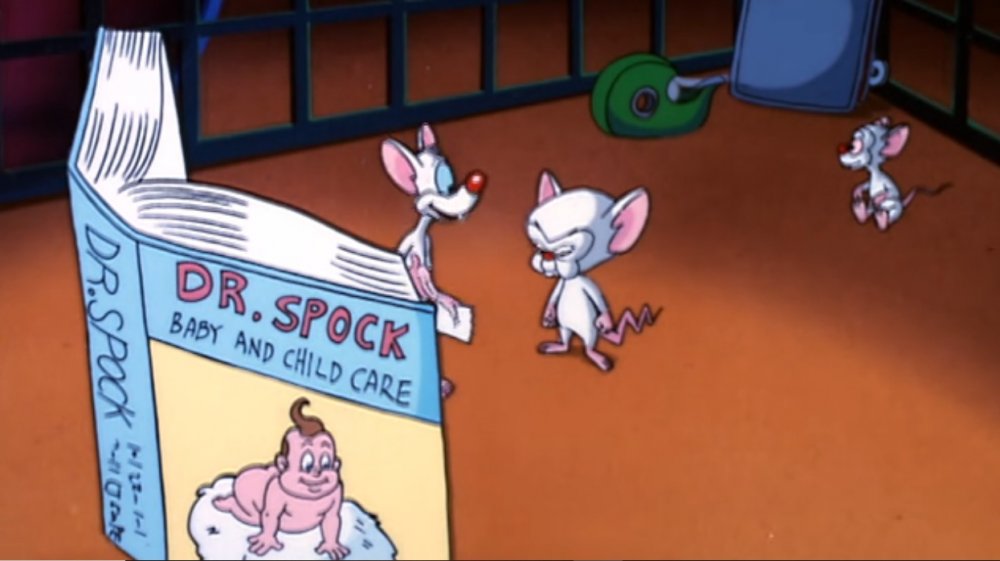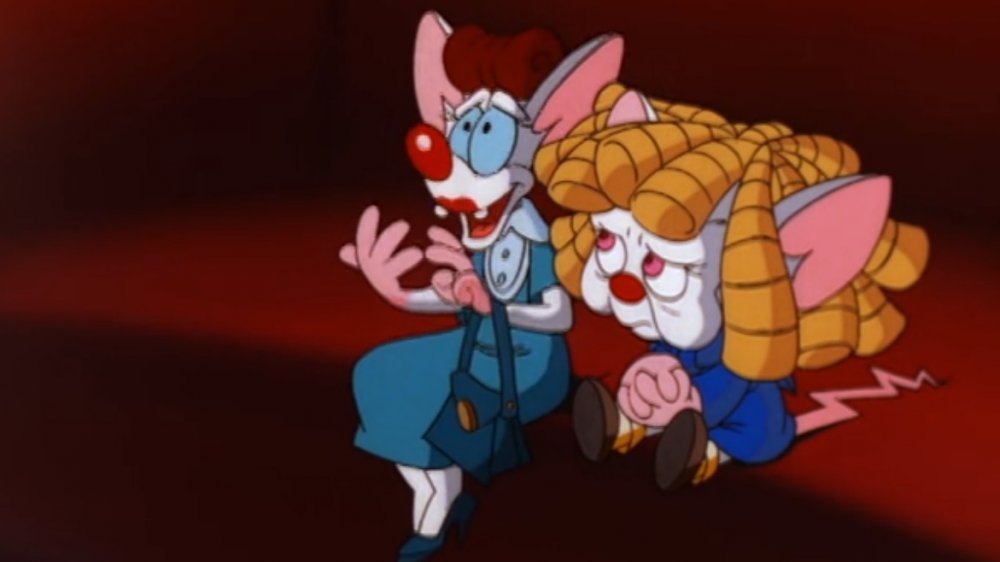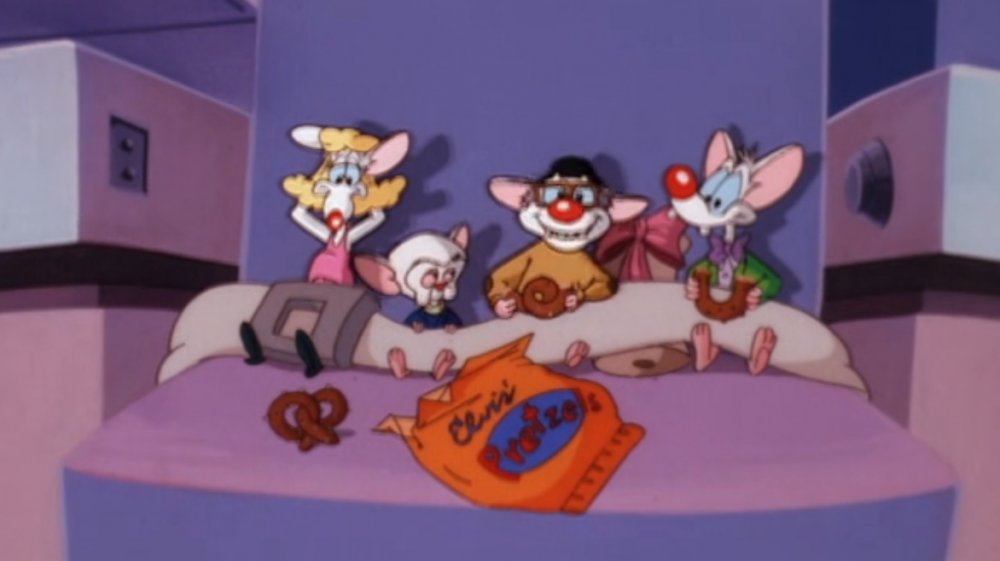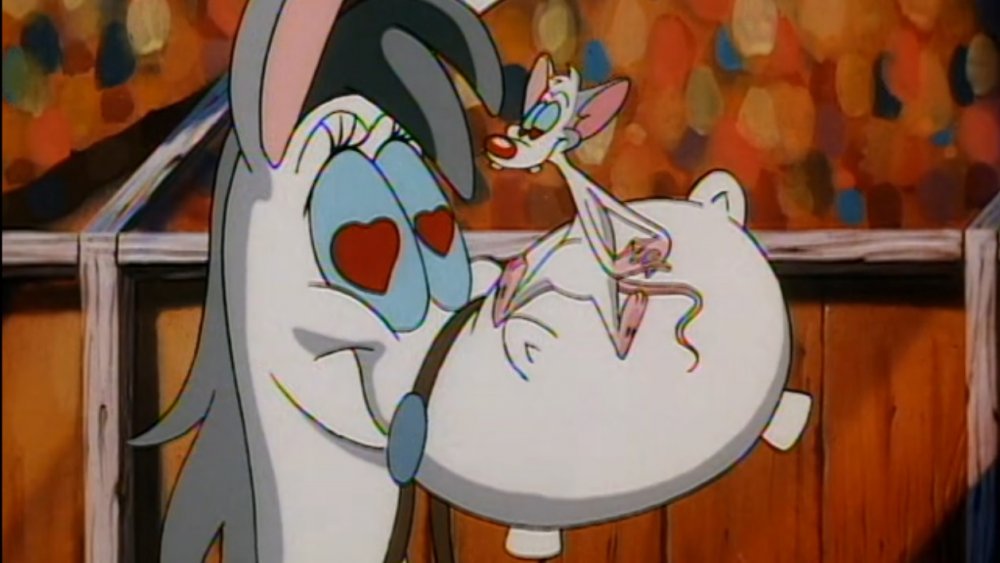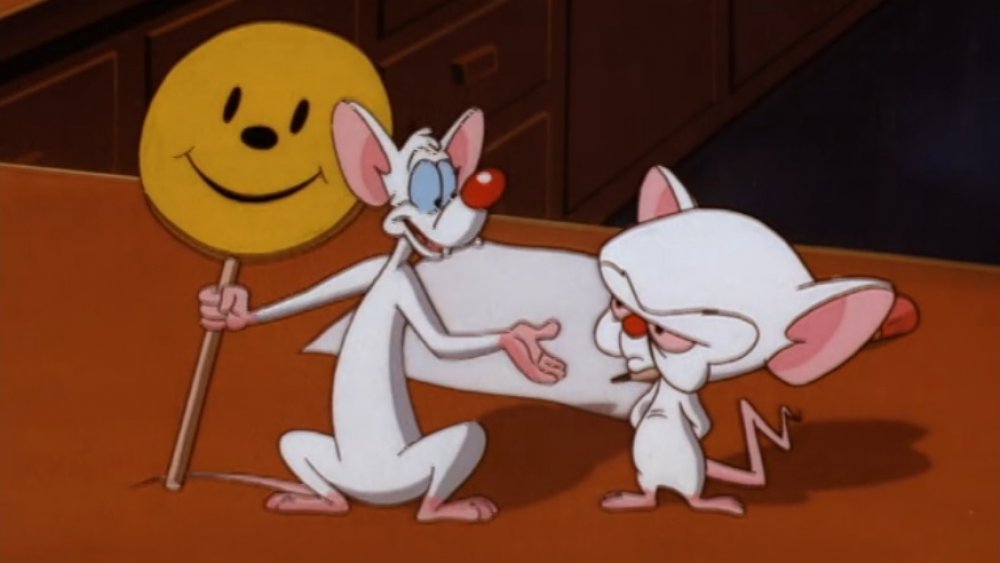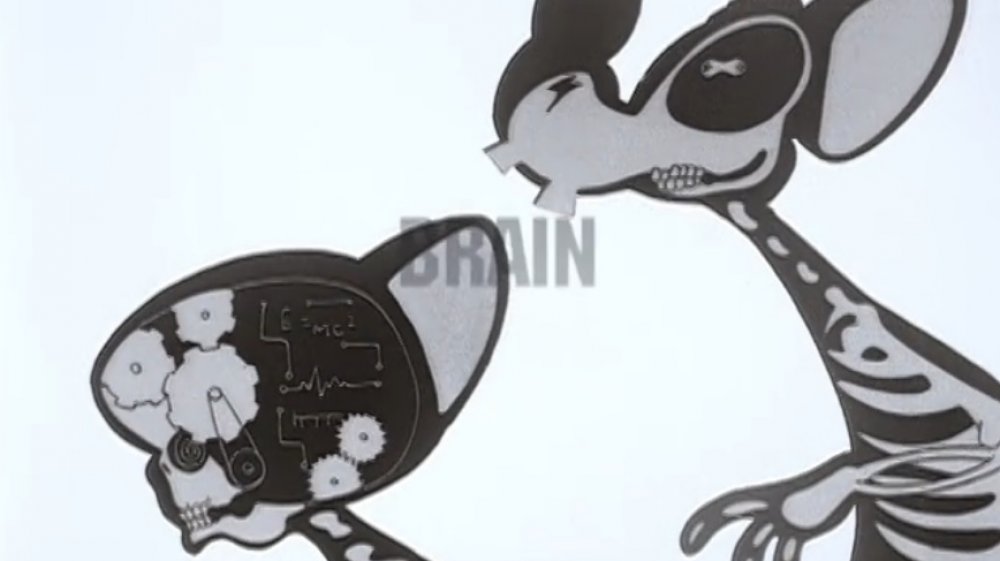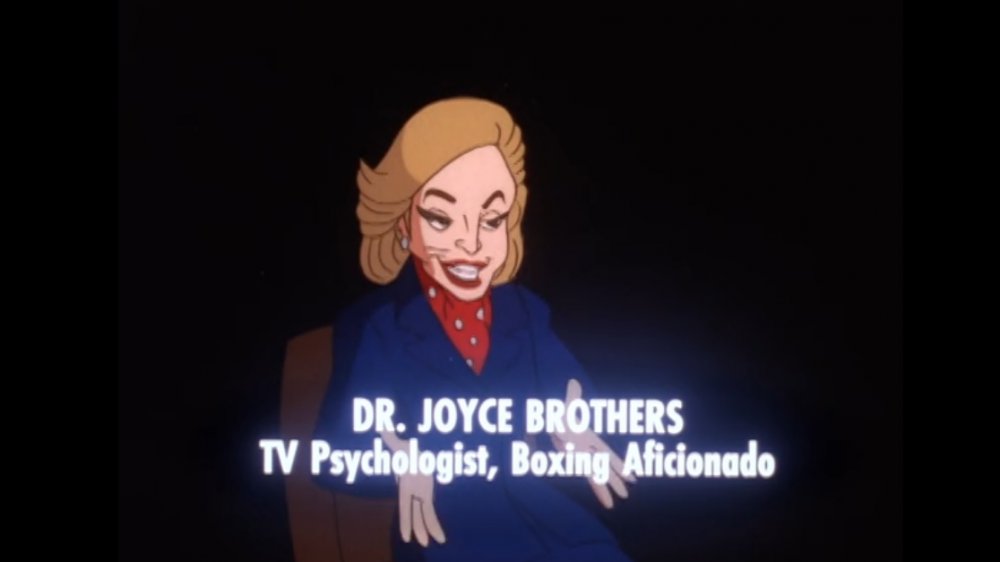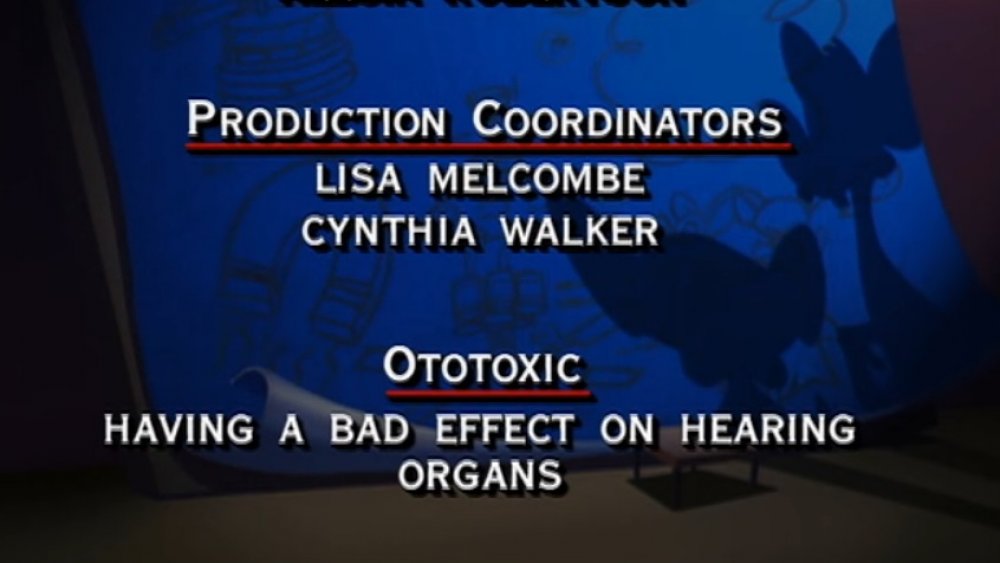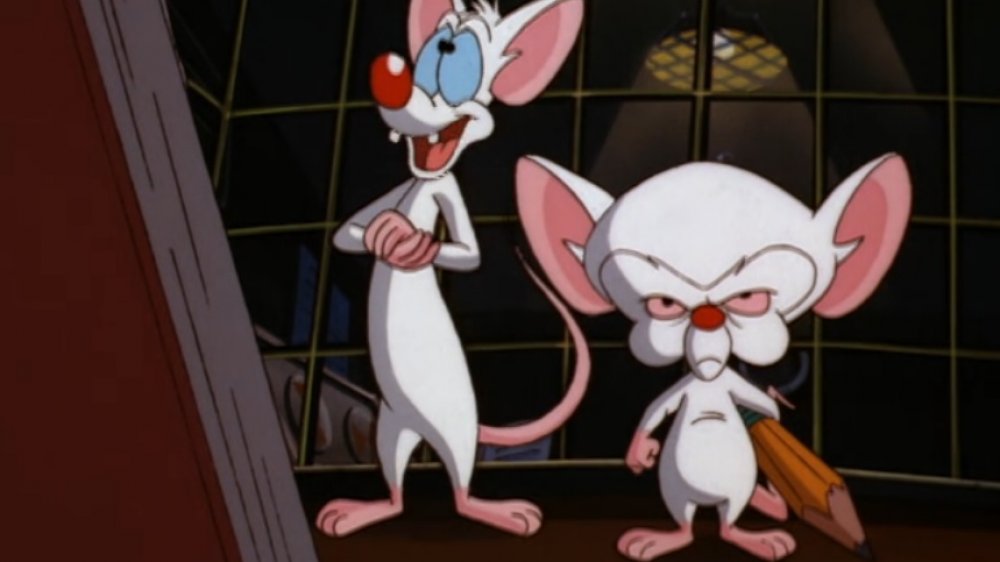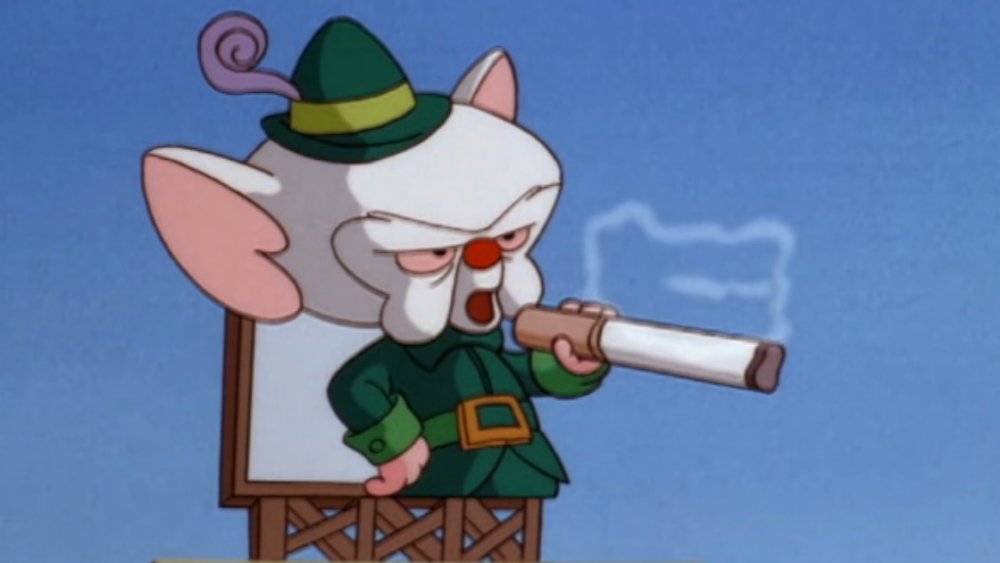Things Only Adults Notice In Pinky And The Brain
People are still talking about the success of Pinky and the Brain years after the Warner Bros. Animation's Animaniacs spin-off show came to an end. After all, who doesn't love a story about two mice — one a genius, the other insane — who try to take over the world every single night? The show was insanely popular with kids, but all this time later, it's pretty obvious there were quite a few gags in there for grown-ups, as well.
After all, while it's not uncommon for children's shows to be sprinkled with references that only adults understand, Pinky and the Brain is full of so many obscure historical references, pop culture parodies, progressive ideals, and adult themes that it's hard to classify it as a true children's program, even though the show originally aired on Kids WB. And today, we're going to prove our mousy worth by pointing out some of the things in Pinky and the Brain that only adults notice.
Pinky and the Brain is full of historical references
Dealing with historical topics in cartoons made for children with notoriously short attention spans can be a bit of a challenge. However, the writers of Pinky and the Brain tackled the challenge head-on often by using catchy musical numbers and creative humor. For example, Cleopatra, Hannibal, Attila the Hun, Caligula, Napoleon Bonaparte, and other famous figures of history are described by the daft duo in the song "A Meticulous Analysis of History." Kids will remember the catchy tune and even the names of the figures, but some of the details may not leave an impression.
Other historical references are a little less obvious and take a keen ear to pick up on. The episode "A Pinky and the Brain Christmas" sneaks in an indelicate joke about one of the most infamous events in American history. When Pinky exclaims that Santa's reindeer are inviting them to a party at Donner's house, the Brain says he isn't too keen on being invited to the Donner party. Needless to say, this cannibalistic reference wasn't mean for kids to understand.
All the adult pop culture parodies
Animated kids' shows have a long history of making pop culture references. (We're looking at you Shrek ... and Aladdin ... and Toy Story.) And of course, some of the pop culture parodies that appear in Pinky and the Brain, including Winnie the Pooh and the Macarena, are so obvious that even kids can pick up on them. However, there are some that children are less likely to recognize. For example, Bill Grates and Microsponge are in reference to Bill Gates and Microsoft. The Feebles in "All You Need is Narf" are a reference to the Beatles, and the title of the episode is obviously paying homage to the Fab Four's "All You Need is Love." Yoko Ono's persona even makes an important appearance in the form of the character Yoyo Nono. Adults watching the episode are able to pick out the facts in the retelling of events, while kids likely just stick around for the silly humor.
Pinky and the Brain might be same-sex life partners
At first glance, Pinky and the Brain's relationship appears to be that of co-workers who share the common goal of total world domination. When we take a closer look at their interactions, however, it's clear that Pinky and the Brain are actually friends who care very deeply for each other. The ever faithful Pinky is always quick to go along with the Brain's crazy plans, even when it involves him dressing in drag and pretending to be Brain's wife in the episode "My Feldmans, My Friends."
Their friendship is put to the ultimate test in "A Pinky and the Brain Halloween" when Brain is forced to choose between saving Pinky's soul or the ability to achieve his lifelong goal of ruling the world. To the audience's surprise, Brain chooses to try and save Pinky, although he claims he made this decision due to the fact that Pinky knows the location of their food pellets. Then, in two specific episodes, we see the pair work together as co-parents. In "Two Mice and a Baby," they take on the task of raising a superhuman son, with Pinky as the mother figure and Brain as the father figure. The same roles reappear in the episode "Brinky," but this time, the couple is in charge of raising their biological offspring. They pull off these roles with a great degree of comfort and ease, leaving the audience with a few questions about the true nature of their relationship.
Both Pinky and the Brain crossdress in multiple episodes
Brain's overly complex plans to take over the world often include him and Pinky having to play dress-up. In several episodes, they end up disguising themselves as female characters, and they often do so quite successfully. In the episode "Brain's Bogie," Brain dresses up as a comically long-legged superstar Cher in order to compete in golfing tournament.
On more than one occasion, they disguise themselves as females even when it doesn't seem like the easiest option. For example, in "Whatever Happened to Baby Brain," Brain pretends to be a young girl named Baby Brain, modeled after "America's Little Darling" Shirley Temple. When it comes time for Baby Brain to sign a contract after finally making her big break, Brain tells the producer that Pinky is his mother. This seems like an odd thing to do since Pinky could more easily pull off the role of Baby Brain's father.
Plus, Pinky doesn't skip a beat in "A Little Off the Top" when Brain orders him to dress up and seduce Samson, while Brain attempts to steal a ring from the biblical warrior. As an adult, it's refreshing to have such cases of gender fluidity go unnoticed by child audiences.
Both sets of mousy parents are accepting of Pinky and the Brain's relationship
In an episode titled "The Visit," the viewers get the opportunity to meet the Brain's parents. While they seem to be highly critical of the Brain's physical lifestyle, their judgmental behavior isn't directed at Brain's friendship with Pinky. In fact, they're very fond of Pinky and his silly sense of humor. By the end of the episode, we learn that the Brain and Pinky are both invited to his parents' place for Thanksgiving, an offer that Brain assumes without question that Pinky will accept.
This invitation may not mean much to a younger audience, but adults can't ignore how it might represent a deeper understanding of the Brain and Pinky's relationship on the part of Brain's parents. We also discover that Pinky's parents are equally as fond of Brain in "The Family that Poits Together, Narfs Together," when they describe Brain as being sensible and ambitious, two traits that they themselves possess.
Pinky has an unusual attraction to horses
Look, we're not here to judge Pinky, but it's pretty obvious that the guy has a thing for horses. Need proof? Well, the Brain's comments about the Roman emperor Caligula and his love of his horse in "A Meticulous Analysis of History" prompts Pinky to sing, "What's wrong with being friendly with a thoroughbred?"
Then, during a skit from an episode of The Animaniacs titled "Jockey for Position," Pinky falls in love with a female racehorse named Phar Fignewton. Evidence in later episodes of Pinky and the Brain prove that this horse is in fact Pinky's girlfriend. In "The Third Mouse," Pinky defends his love for the mare and exclaims that, "People are so intolerant." To kids, this relationship may not seem all that unusual since the show is a cartoon, but the adults in the audience recognize that Pinky and Phar Fignewton's relationship is representative of something much bigger. The writers use Pinky's quirky love life as a vehicle for showing that relationships that include diversity are acceptable in society and should be the norm.
The humor can be a little racy at times
In nearly every single episode of the show, the Brain poses the same exact question: "Are you pondering what I'm pondering, Pinky?" However, Pinky's response is always completely unpredictable and often laugh-inducing for the audience. In fact, some of his quips are even a little off-base, at least to members of the audience that are considered to be more mature.
For example, Pinky's saucier responses include the time he said, "I think so, Brain. But this time I get to play the dishwasher repairman!" And then there's the even more scandalous response of, "I think so, Brain! But is Chippendale's ready for 'the Full Pinky?" To an innocent mind, these instances might not seem so cheeky since the references could be interpreted differently. But when it comes to the mind of an adult, well, it's really easy to wind up in the gutter.
Which one is the genius, and which one is insane?
Besides being one of the most catchy cartoon theme songs of all time, the Pinky and the Brain theme clearly spells out the plot of every episode. The song also includes the phrase,"One is a genius, the other's insane." During this specific part of the intro, we see an x-ray of the Brain's head and Pinky's head. The image of the Brain's skull appears to be full, and Pinky's skull is quite empty. These visuals lead the audience to believe that Pinky is insane while Brain is the genius, but it's hard to ignore that the order of the characters in the title of the show and in the song might mean that Pinky is in fact the genius while the Brain is insane. This theory is supported by the Brain's many failed attempts to take over the world. It's also supported by the fact that Pinky seems to often know that the Brain's plans will fail before he even puts them into action.
Surprisingly famous guest appearances in Pinky and the Brain
The creators of Pinky and the Brain loved to fill their episodes with parodies of celebrities, voiced by less-than-famous voice actors. However, some episodes featured real celebrities playing themselves. For example, in "The Pinky and the Brain Reunion Special," both Dick Clark and Dr. Joyce Brothers make an appearance (well, an animated/vocal appearance, anyway). Of course, while these cameos are special to most adults in the audience, they most likely go unnoticed by anyone in the younger demographic.
However, there was another way of sneaking celebrities into the episode, and that was by having them join the cast as voice actors playing fictional characters. For example, Mark Hamill, Ben Stein, and Jeffrey Tambor all showed up as part of the sneaky, star-studded cast list. And while anyone could recognize these people by sight, only true fans are able to distinguish the voice of their favorite actors when it's disguised as a colorful cartoon character.
Every episode has a closing credits surprise
There probably aren't many kids that stick around for the final credits of cartoons, but that didn't stop the Pinky and the Brain creators from including an educational surprise at the end of every episode. Hidden among the names of those who put in the hard work to create such an intelligent and enjoyable cartoon are fancy words that we can only assume the Brain picked to enhance the story of each episode.
In the closing credits of "All You Need is Narf," the word "ototoxic" is defined as "having a bad effect on hearing organs." This could very well be in reference to Yoyo Nono's ear-shattering vocal performance in the episode. And a word that shows up in the final credits of "Napoleon Brainaparte" is honorificabilitudinitatibus, which is defined as "with honorableness." These words likely go unnoticed by younger audiences, but they're so strange and unique that they definitely stand out to adults.
Each episode follows the same structured pattern
It doesn't take a genius to notice that the writers of Pinky and the Brain often used some creative freedom when coming up with the storylines for each episode. After all, guest characters on the show rarely reappear (for example, Larry), and each episode is a unique new adventure that often takes place in a new environment. The crazy chaos that's often the result of Brain's plan for world domination would seem much more outlandish if the writers didn't stick to a foolproof formula that always involves the same elements. These elements include deploying a plan to take over the world, the ultimate failure of the plan, and Brain starting the process all over again. Keeping this pattern is important because as Brain's plans get more far-fetched, the audience still finds them believable because we have the structured formula to fall back on.
Pinky and the Brain covers some adult issues
It's unusual for a cartoon to take on the task of conveying truly adult issues such as politics, drug use, sexual harassment accusations, and addiction in an honest but still entertaining manner. But in the award-winning episode "Inherit the Wheeze," the Brain becomes addicted to smoking cigarettes after being tested on in the lab. After experiencing the sickly side effects first hand, he decides to become a spokesman for the tobacco company to ultimately raise awareness on how bad smoking truly is for your health. And in the episode "Megalomaniacs Anonymous," the Brain realizes that he suffers from an addiction and attends meetings to attempt the breaking of his unhealthy habits. Unfortunately, the meetings have the opposite effect. On top of all that, the show also makes use of politics, with people like Rush Limbaugh, the Clintons, and Al Gore coming up often in a satirical manner that only adults would take note of.
